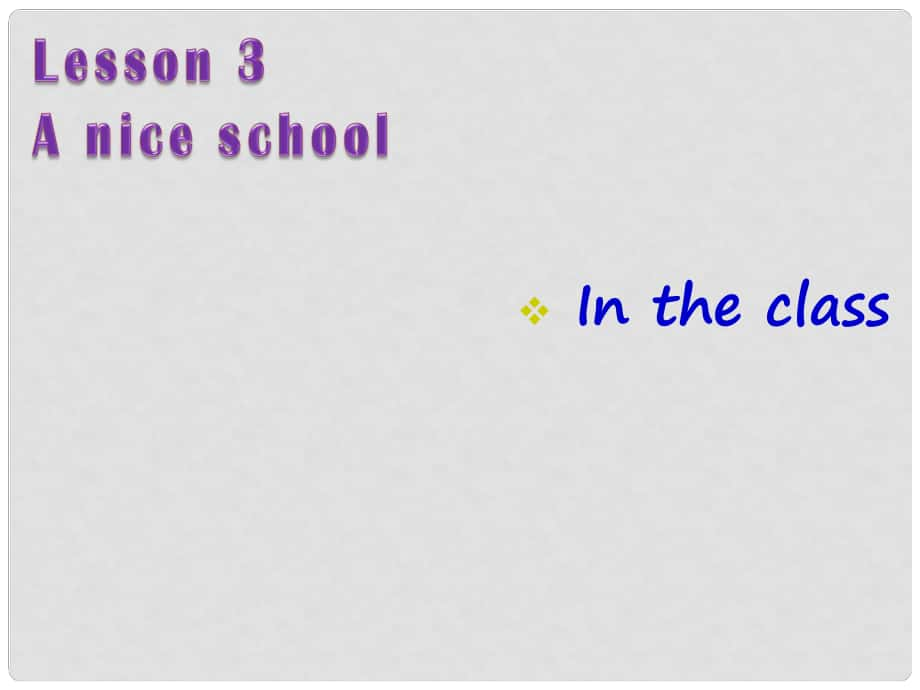《江蘇省鹽城市亭湖新區(qū)實(shí)驗(yàn)學(xué)校七年級(jí)英語(yǔ)《Lesson 3 A nice school》課件1 牛津譯林預(yù)備版》由會(huì)員分享�����,可在線閱讀��,更多相關(guān)《江蘇省鹽城市亭湖新區(qū)實(shí)驗(yàn)學(xué)校七年級(jí)英語(yǔ)《Lesson 3 A nice school》課件1 牛津譯林預(yù)備版(41頁(yè)珍藏版)》請(qǐng)?jiān)谘b配圖網(wǎng)上搜索�。
1��、v In the class短語(yǔ)翻譯短語(yǔ)翻譯1�、一張我的全家福、一張我的全家福2��、長(zhǎng)著長(zhǎng)頭發(fā)的女人�����、長(zhǎng)著長(zhǎng)頭發(fā)的女人3、在一個(gè)大的醫(yī)院����、在一個(gè)大的醫(yī)院4、說(shuō)英語(yǔ)���、說(shuō)英語(yǔ)a photo of my familythe woman with long hairin a big hospitalspeak English5��、看起來(lái)年輕���、看起來(lái)年輕6、有一個(gè)男嬰�、有一個(gè)男嬰7、有一個(gè)幸福的家庭���、有一個(gè)幸福的家庭8�、十二歲��、十二歲9��、我的父母��、我的父母10、一個(gè)姨媽一個(gè)伯父�����、一個(gè)姨媽一個(gè)伯父look younghave a baby sonhave a happy familytwelve years
2�����、oldmy parents/my father and motheran aunt/an uncle11��、Mary阿姨阿姨/我的阿姨我的阿姨Mary12����、一位英語(yǔ)老師、一位英語(yǔ)老師 13�����、兩名男醫(yī)生���、兩名男醫(yī)生Aunt Mary/my aunt Maryan English teachertwo men doctors二、詞匯練習(xí):二�、詞匯練習(xí):1.My aunts son is my c_.2.The man is my fathers brother, he is my u_.3.My name is Sally. I have a happy f_.4.His father is a t
3、_.He works in a middle school. 5.My grandma is sixty years old,but she looks y_.ousinncleamilyeacheroung6.Look at the_(照片照片). They are nice.7.There are _(四十四十) students in Lilys class.8.I have two brothers , I love_ (他他們們)very much.9.I want to have a house _ (帶有帶有) a garden.10.Oh,the _(嬰兒嬰兒)are very
4��、 lovely.photosfortythemwithbabies三、按要求改寫(xiě)下列句子:三���、按要求改寫(xiě)下列句子:1����、That man is my father. (劃線提劃線提問(wèn)問(wèn))2�����、That man is a doctor.(同上同上)3���、This is my grandpa.(一般疑問(wèn)一般疑問(wèn)句��,并作肯定回答句��,并作肯定回答)Who is that man?What is that man?Is this your grandpa?Yes ,he is.四�、翻譯句子1.這位是我的表妹凱特�����。這位是我的表妹凱特�。 2 你好你好!這位是尼克叔叔嗎?是的����。這位是尼克叔叔嗎�?是的���。3 你的舅媽是
5���、干什么的?你的舅媽是干什么的����?她是一名醫(yī)生。她是一名醫(yī)生�����。This is my cousin Kate.Hello ! Is this Uncle Nick? Yes,he is.Whats your aunt? She is a doctor.4 ���、*那是什么��?是一張托尼的全家照。那是什么���?是一張托尼的全家照�。5 、這位長(zhǎng)頭發(fā)女士是誰(shuí)��?�����、這位長(zhǎng)頭發(fā)女士是誰(shuí)�?6、我沒(méi)有兄弟姐妹���,但我有堂�����、我沒(méi)有兄弟姐妹�����,但我有堂(表表)親�����。親���。Whats that? Its a photo of Tonys family.Whos the woman with long hair? I have no bro
6����、thers or sisters, but I have cousins.WORDS:名詞:名詞:1����、時(shí)間、時(shí)間2����、書(shū);本子����、書(shū);本子3�����、書(shū)頁(yè)�、書(shū)頁(yè)4、圖片�����;照片、圖片����;照片5����、燈、燈6�����、黑板���、黑板7���、字;詞�;話語(yǔ)、字����;詞;話語(yǔ)8�、磁帶、磁帶9、回答����;答復(fù)、回答���;答復(fù)timebookpagepicturelightblackboardwordtapeanswer動(dòng)詞:動(dòng)詞:1�、站�����,立�����、站�,立2、打開(kāi)���、打開(kāi)3����、翻轉(zhuǎn)����;旋轉(zhuǎn)�����、翻轉(zhuǎn);旋轉(zhuǎn)4����、坐、坐5����、關(guān);關(guān)閉�、關(guān);關(guān)閉6���、朗讀����;閱讀��、朗讀�;閱讀7、聽(tīng)、聽(tīng)8�、書(shū)寫(xiě);寫(xiě)作���、書(shū)寫(xiě)���;寫(xiě)作standopenturnsitclosereadlistenwrite
7、1����、給;為����;往;向����、給;為�����;往�����;向2、向上��、向上3����、向下、向下4���、請(qǐng);請(qǐng)問(wèn)��、請(qǐng)����;請(qǐng)問(wèn)5、對(duì)��;向���;到����、對(duì);向�;到6、對(duì)的����;正確的;合適的�����、對(duì)的��;正確的�;合適的7、現(xiàn)在���、現(xiàn)在8����、在(某處)��;在(幾點(diǎn)鐘)�����、在(某處);在(幾點(diǎn)鐘)9����、在、在之后之后10�、又,再���,再一次����、又��,再����,再一次forupdownpleasetorightnowat afteragain11�、是、是.的時(shí)候了的時(shí)候了12���、起立����;站立、起立����;站立13、坐下����、坐下14、翻到����、翻到15、(某處)有���、(某處)有16�、寫(xiě)下�;記下、寫(xiě)下���;記下17��、練習(xí)本�����、練習(xí)本Its time forstand upsit downturn tothere
8�、 is/arewrite downexercise book詞匯練習(xí):詞匯練習(xí):1.-Whats in the_(圖片圖片)? - Theres a cat.2._(打開(kāi)打開(kāi))the door,please.3.Dont _(關(guān)閉關(guān)閉)the window.4.Mum, I want to _(聽(tīng)聽(tīng))to music.5.You are late_(又����,再又,再).6.Open your books and _(翻翻) to _(頁(yè)頁(yè)) 12.pictureOpencloselistenagainturnPage7.I cant read these _(單詞單詞). Can you read
9����、 them for me?8.Its t_for class.9.Sit d_,please.10.Please _ _(寫(xiě)下寫(xiě)下)your words in your books.11.Please turn on (打開(kāi)打開(kāi)) the_ (燈燈), I cant see the words on the blackboard.12.Can you tell me the _(答案答案)to the question?wordsimeownwrite downlightsanswerreadread a bookread the new words after me listenlisten
10、 to musiclisten to the tape writewrite in the bookwrite down your answers in your exercise books open open the dooropen your book xl closeclose the doorclose your book stand upsit downPicture1:Whats the time for?Picture2:Which page does the teacher ask the students to turn to?Whats in Picture 1?Pict
11�����、ure 3:What does the teacher ask them to do?Picutre4:What do the students do?LISTEN AND ANSWERLISTEN AND ANSWERPicture1:Whats the time for? Its time for class. Whos the teacher? Miss Li.Picture2:Which page does the teacher ask the students to turn to?Whats in Picture 1? Page 6. Theres a light.Picture
12��、 3:What does the teacher ask them to do? She asks them to close their books,look at the blackboard and read the new words after her.Picutre4:What do the students do? They listen to the tape again and write down their answers in their exercise books.LISTEN AND ANSWERRead Part A1 and try to act out th
13�����、e dialogue.Read and complete Part A2Grammar(語(yǔ)法語(yǔ)法)祈使句:當(dāng)請(qǐng)求或命令別人做某事時(shí)����,常用祈使句:當(dāng)請(qǐng)求或命令別人做某事時(shí)�,常用 祈使句�。特征:以動(dòng)詞原形開(kāi)頭����。祈使句。特征:以動(dòng)詞原形開(kāi)頭����。Stand up.Close the door.Write down the new words on the blackboard.祈使句的否定形式:在句首祈使句的否定形式:在句首(動(dòng)詞前動(dòng)詞前)加加Dont. Dont open your books.Dont be late again.祈使句句型轉(zhuǎn)換 1.Clean the window.(否定句否定句)
14、 2. be late for school.(否定句)(否定句) 3.Look at the blackboard.(否定句)(否定句) 4.You stand up now. (祈使句祈使句) 5.You cant go to school.(祈使句祈使句) Dont clean the window.Dont be late for school.Dont look at the blackboard.Stand up now.Dont go to school.1.請(qǐng)看我的這些照片���。請(qǐng)看我的這些照片����。2.讓我看一看���。讓我看一看��。3.請(qǐng)讓他們坐下來(lái)�����。請(qǐng)讓他們坐下來(lái)��。4.不要關(guān)門(mén)�����。不要關(guān)門(mén)
15��、�����。5.不要看我�,請(qǐng)看他們。不要看我����,請(qǐng)看他們。Please look at my photos.Let me have a look.Let them sit down, please.Dont close the door.Dont look at me, please look at them.ConsolidationConsolidation一����、選擇:一、選擇:( )1.Its time _school. A.to B.for C.in D.to go( )2.-Sit down,please.-_. A.OK B.All right C.Thanks D.Yes ,I am.( )3
16����、.Look at the words on the blackboard .Please _. A.Write down them B.write them down C.write it down D.write down itBCB二����、翻譯下列句子:二��、翻譯下列句子:1�����、上課的時(shí)間到了����。�、上課的時(shí)間到了。 Its _.2���、把你們的書(shū)打開(kāi)�,翻到第��、把你們的書(shū)打開(kāi)�����,翻到第14頁(yè)����。頁(yè)。 _and_ _.3、合上你們的書(shū)��,看黑板��。�、合上你們的書(shū),看黑板�����。 _and_ _. time for classOpen your books turn to Page 14Close your books l
17�����、ook atthe blackboard4.跟我讀新單詞��。跟我讀新單詞�����。 _.5.再聽(tīng)一遍磁帶��。再聽(tīng)一遍磁帶���。 _.6.在你們的練習(xí)本上寫(xiě)下你們的答在你們的練習(xí)本上寫(xiě)下你們的答案�。案。 _ _.Read the new words after meListen to the tape againWrite down your answers inyour exercise booksHOMEWORK:1�、復(fù)習(xí)祈使句的結(jié)構(gòu)形式���。�����、復(fù)習(xí)祈使句的結(jié)構(gòu)形式���。2、背誦��、背誦Part A1�。3、預(yù)習(xí)���、預(yù)習(xí)Part B1,要求背誦要求背誦P15的單詞��,的單詞�,并熟讀課文��,完成并熟讀課文�,完成Part B2���。
 江蘇省鹽城市亭湖新區(qū)實(shí)驗(yàn)學(xué)校七年級(jí)英語(yǔ)《Lesson 3 A nice school》課件1 牛津譯林預(yù)備版
江蘇省鹽城市亭湖新區(qū)實(shí)驗(yàn)學(xué)校七年級(jí)英語(yǔ)《Lesson 3 A nice school》課件1 牛津譯林預(yù)備版

